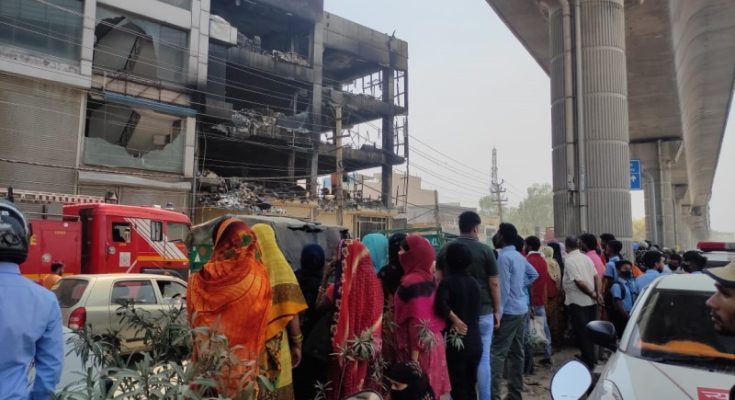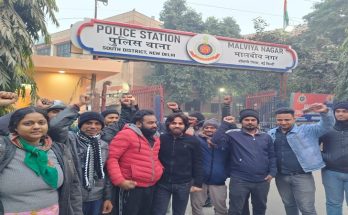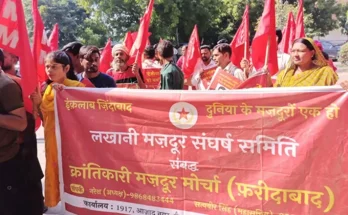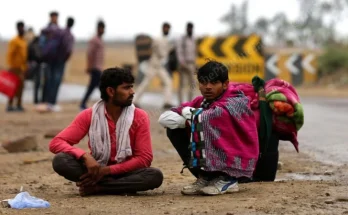By Anumeha Yadav and Arya Thomas
In mid-May, as many in the Capital switched on their air-conditioners and stayed indoors to beat a 47°C heatwave, a fire broke out in one of Delhi’s several illegally operated factories. Within hours, the blaze killed 27 persons working there on a Friday evening. It was primarily young women who got asphyxiated and burnt in the devastating factory fire. As reported by newspapers, of the 27 confirmed dead the same night, 21 were women workers, and of 29 who remained missing till May 16 – feared to be dead – the vast majority, 24, were women.
Most responses have been about the Mundka fire as a “disaster”, or how building norms were flouted. But the incident, which has claimed so many women’s lives, lays bare the asymmetries in the working conditions for women. It suggests that, although the thrust of policy has been to get women into the workforce, there is an absence of conversation about the terms they are compelled to accept when they enter the workforce.
Large numbers of women were employed in industrial work in the business being run without a factory license in a residential building a few meters from a busy metro station in west Delhi.
In interviews to one of the writers, they stated that they assembled, soldered, and packed 1,000 to 1,500 pieces of CCTV cameras, Wi-fi routers, circuit adapters daily in three assembly lines run on two floors of the factory, while a middle floor served as the office from where they were paid Rs 6,500 monthly in cash in envelopes, without pay slips, contracts, or provident fund. One woman worker recounted that the previous month, a few of their colleagues had negotiated a pay increase of Rs 1000, taking the monthly wage to Rs 7,500 (Rs 288 a day). Even after the increase, it was less than half of Delhi’s minimum wage they were legally entitled to for industrial work, at the rate of Rs 16064/month (Rs 618/day) even for “unskilled work”, and 17693/a month (Rs 681/day) for “semi-skilled work”.
The women clarified that the factory attracted a majority of women workers despite the low pay because the employers allowed them to work in shifts from 10 am to 7 pm. This meant that they were able to do household work in the morning before starting paid work in a building not far from their homes.
Another condition they explained in interviews as a “suvidha” (a service, or ease) was that the company allowed them to sit while working and that there were fans installed at even their work stations on the assembly line. They described these as vast improvements over many other factories where they had worked in temporary jobs earlier in Delhi, including in textile export units where they were required to stand for 9 to 10 hours a day and work.
Successive central governments have projected women as the latent labour force that will propel India’s economic growth. In a bid to improve India’s low female labour participation rate – which fell to 19 percent in 2020 from 26 percent in 2005 – the current union government has helmed in changes in labour laws to make it easier to hire women in night shifts, and focused on programs such as “Skill India” to target women from marginalized communities in remote villages, aiming to have 50 percent women in trainings to draw women into manufacturing and retail. Then, is the devastation in Delhi’s Mundka what administrators want India’s ambition of women’s participation in the labour force to look like in practice? With its silence on appropriate treatment and preventative measures to ensure dignity or even a worker’s life at the workplace, it is fairly evident that the government appears more to be projecting a seemingly progressive outlook to facilitate the entry of cheap female labour into the economy, rather than actually ‘empowering’ women. This incident as well as the daily life struggle of millions of working-class women stands testimony to the fact that the government has no agenda for dignified employment and well-being for women.
- While BJP, AAP pass the buck, victims’ kin run from pillar to post
- Sole bread earner of family, still missing since Mundka fire
The obvious lack of consensus to this model can also be gauged from incidents when workers themselves have stepped out to fight for their rights, such as Foxconn women workers whose protests against the living conditions in the crowded dorms temporarily shut down the Chennai plant in December 2021, or of Bengaluru garment workers who demonstrated for days in 2016 for their right to access their provident fund accounts, or even the actions by domestic workers who alleged that Zohra Bibi, their neighbour, who cleaned houses, was in captivity in an apartment complex in Noida, Uttar Pradesh in 2017.
Each of these protests exposes, like the Mundka fire, the unsettled questions of decent working conditions, lack of social security, theft of minimum wages, and even the threat of loss of their lives while working. Despite the claim of women’s empowerment ringing through state discourse, reality points in very different directions – that even when there is employment generation for women, it is primarily as casual informal workers, with no minimum wage protections, or social security. Their working conditions are unregulated to the extent that in factories, women are employed way below minimum wages, are routinely paid less than male workers for the same work despite working more than 8 hours a day and often, the work entails long hours of standing, with difficulty in accessing even toilet breaks. This is the norm across several categories of workplaces – big and small, and formal and informal sectors.
The Maternity Entitlements Act, which provides 26 weeks of paid leave to women formally employed in the organized sector leaves out women working without written contracts. This is when as per the Periodic Labour Force Survey, less than a third of all of India’s workers hold written contracts at all. Economist Reetika Khera has shown that the maternity benefit provision in the Food Security Act, 2013, now the PM Matru Vandana Yojana, which could benefit women who lack formal work contracts, has been reduced from Rs 6,000 to Rs 5,000 and restricted to one child. Further, the lack of state-led provisions for child care (creches) means that women are either forced to let go of work, or depend on kinship or other neighbourhood support, and find it more ‘suitable’ to work in a factory like in Mundka where the burden of housework can be ‘adjusted and balanced’ along with paid work.
The Triangle Shirtwaist factory fire in America which killed 146 garment workers, majority of whom were immigrant women, propelled a new movement for safer conditions of work. The Rana Plaza disaster in 2013, which killed 1,132, awoke the world to the hardship and working conditions of the majority of young women working in Bangladesh’s garment firms. It led to a global effort to transparently calculate loss of income payments as per ILO Conventions, and action on appropriate health care and compensation to the victims. The mass deaths of these workers led to crucial rethinking on industry standards.
India witnesses industrial accidents on a daily basis due to criminal negligence on the part of administrators and elected officials. The untimely death of these young women workers and the grief of so many families must lead us to proactive steps. The government must acknowledge the value of women’s lives, their work inside homes and offices, and guarantee their safety at the workplace.
(Courtesy: Hindustan Times)
(वर्कर्स यूनिटी के फ़ेसबुक, ट्विटर और यूट्यूब को फॉलो कर सकते हैं। टेलीग्राम चैनल को सब्सक्राइब करने के लिए यहां क्लिक करें। मोबाइल पर सीधे और आसानी से पढ़ने के लिए ऐप डाउनलोड करें।)



